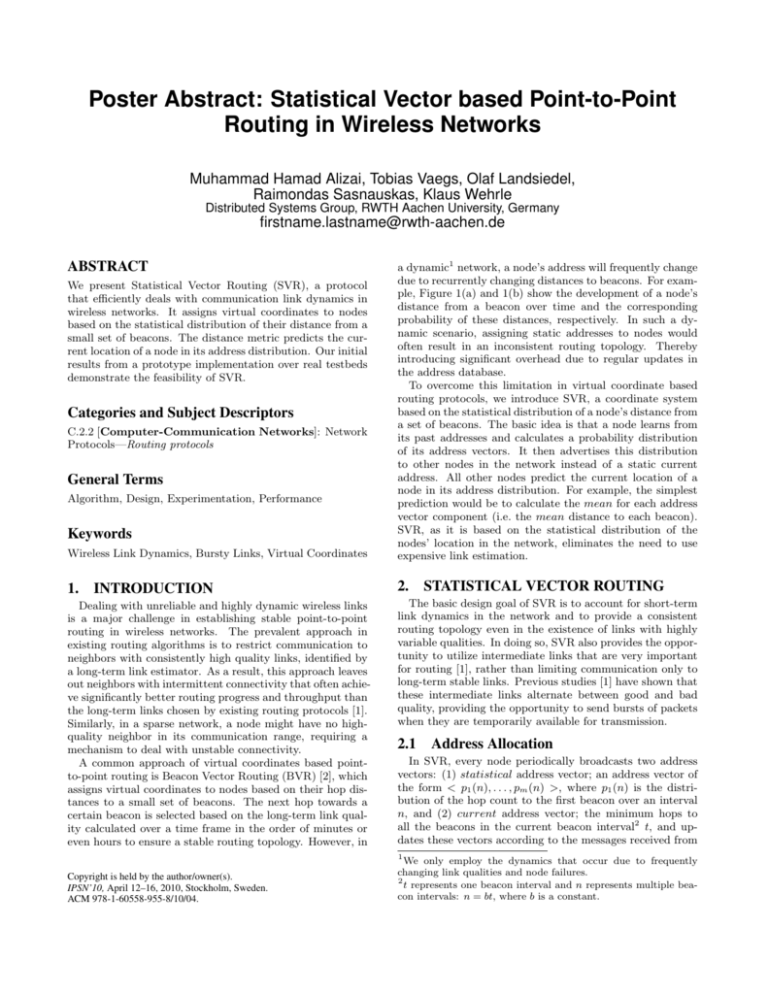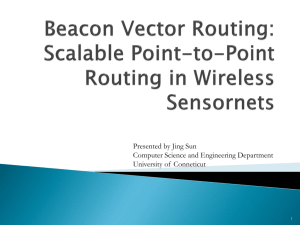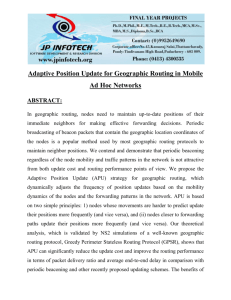Statistical Vector based Point-to-Point Routing in Wireless Networks
advertisement

Poster Abstract: Statistical Vector based Point-to-Point Routing in Wireless Networks Muhammad Hamad Alizai, Tobias Vaegs, Olaf Landsiedel, Raimondas Sasnauskas, Klaus Wehrle Distributed Systems Group, RWTH Aachen University, Germany firstname.lastname@rwth-aachen.de ABSTRACT Wireless Link Dynamics, Bursty Links, Virtual Coordinates a dynamic1 network, a node’s address will frequently change due to recurrently changing distances to beacons. For example, Figure 1(a) and 1(b) show the development of a node’s distance from a beacon over time and the corresponding probability of these distances, respectively. In such a dynamic scenario, assigning static addresses to nodes would often result in an inconsistent routing topology. Thereby introducing significant overhead due to regular updates in the address database. To overcome this limitation in virtual coordinate based routing protocols, we introduce SVR, a coordinate system based on the statistical distribution of a node’s distance from a set of beacons. The basic idea is that a node learns from its past addresses and calculates a probability distribution of its address vectors. It then advertises this distribution to other nodes in the network instead of a static current address. All other nodes predict the current location of a node in its address distribution. For example, the simplest prediction would be to calculate the 𝑚𝑒𝑎𝑛 for each address vector component (i.e. the 𝑚𝑒𝑎𝑛 distance to each beacon). SVR, as it is based on the statistical distribution of the nodes’ location in the network, eliminates the need to use expensive link estimation. 1. 2. We present Statistical Vector Routing (SVR), a protocol that efficiently deals with communication link dynamics in wireless networks. It assigns virtual coordinates to nodes based on the statistical distribution of their distance from a small set of beacons. The distance metric predicts the current location of a node in its address distribution. Our initial results from a prototype implementation over real testbeds demonstrate the feasibility of SVR. Categories and Subject Descriptors C.2.2 [Computer-Communication Networks]: Network Protocols—Routing protocols General Terms Algorithm, Design, Experimentation, Performance Keywords INTRODUCTION STATISTICAL VECTOR ROUTING The basic design goal of SVR is to account for short-term link dynamics in the network and to provide a consistent routing topology even in the existence of links with highly variable qualities. In doing so, SVR also provides the opportunity to utilize intermediate links that are very important for routing [1], rather than limiting communication only to long-term stable links. Previous studies [1] have shown that these intermediate links alternate between good and bad quality, providing the opportunity to send bursts of packets when they are temporarily available for transmission. Dealing with unreliable and highly dynamic wireless links is a major challenge in establishing stable point-to-point routing in wireless networks. The prevalent approach in existing routing algorithms is to restrict communication to neighbors with consistently high quality links, identified by a long-term link estimator. As a result, this approach leaves out neighbors with intermittent connectivity that often achieve significantly better routing progress and throughput than the long-term links chosen by existing routing protocols [1]. Similarly, in a sparse network, a node might have no highquality neighbor in its communication range, requiring a mechanism to deal with unstable connectivity. A common approach of virtual coordinates based pointto-point routing is Beacon Vector Routing (BVR) [2], which assigns virtual coordinates to nodes based on their hop distances to a small set of beacons. The next hop towards a certain beacon is selected based on the long-term link quality calculated over a time frame in the order of minutes or even hours to ensure a stable routing topology. However, in In SVR, every node periodically broadcasts two address vectors: (1) 𝑠𝑡𝑎𝑡𝑖𝑠𝑡𝑖𝑐𝑎𝑙 address vector; an address vector of the form < 𝑝1 (𝑛), . . . , 𝑝𝑚 (𝑛) >, where 𝑝1 (𝑛) is the distribution of the hop count to the first beacon over an interval 𝑛, and (2) 𝑐𝑢𝑟𝑟𝑒𝑛𝑡 address vector; the minimum hops to all the beacons in the current beacon interval2 𝑡, and updates these vectors according to the messages received from Copyright is held by the author/owner(s). IPSN’10, April 12–16, 2010, Stockholm, Sweden. ACM 978-1-60558-955-8/10/04. 1 We only employ the dynamics that occur due to frequently changing link qualities and node failures. 2 𝑡 represents one beacon interval and 𝑛 represents multiple beacon intervals: 𝑛 = 𝑏𝑡, where 𝑏 is a constant. 2.1 Address Allocation Probability 12 11 10 9 70 0.25 60 0.20 0.15 0.10 0.05 8 7 0 0.30 20 40 60 0 80 100 120 140 160 180 8 10 12 40 50 40 30 20 30 20 10 10 14 Hops to Beacon Beacon Intervals (10 sec) (a) Development of hop distance from a beacon. 6 50 Interval Length Increase [%] 13 Coordinate Range Decrease [%] Current Hops to Beacon 14 0 - 15 - 25 - 10 -0 Tx Power [dBm] (b) Distribution of hop distance from a beacon. (a) Reduction range in SVR. in coordinate 0 - 10 -0 Tx Power [dBm] (b) Increase in interval lengths of stable coordinates. Figure 1: A node’s distance from a beacon varies significantly over time. its neighbors. Each neighbor is considered alive and usable for transmission as long as at least one beacon message is received from it within interval 𝑛. A node only considers another node as a neighbor if it has a bidirectional link with it, i.e., both nodes hear beacon messages from each other. However, there is no link estimation used to establish these addresses in the network. 2.2 Address Prediction SVR uses three mechanisms to predict the coordinates of the destination depending upon the location of the forwarding node: (1) far away nodes (e.g. more than three hops away) simply use the 𝑚𝑒𝑎𝑛 of the destination’s address distribution to forward the packet in the right direction, (2) a node within a certain vicinity (e.g. two to three hops away) calculates its own shift in the address distribution and expects a similar shift in the destination’s coordinates to predict its current location, and (3) one hop neighbors use the destination’s 𝑐𝑢𝑟𝑟𝑒𝑛𝑡 address vector to forward packets directly. The intuition behind using these three different mechanisms is that it is more probable to predict the destination’s current location closer to it, as nearby nodes are expected to experience similar transmission conditions. 2.3 Routing Metrics In this section we introduce the routing metrics to realize the address prediction mechanism of SVR. The goal is to choose a next hop 𝑝 which minimizes the remaining distance to the destination 𝑑. The address prediction mechanism of SVR utilizes multiple routing metrics. For example, far away nodes use a simple sum distance metric over the mean coordinates to ensure that the packet is heading in the right direction towards the destination. ¯ = 𝛿𝑘𝑠 (¯ 𝑝, 𝑑) 1 ∣𝐶𝑘 (𝑑)∣ ∑ (¯ 𝑝𝑖 + 𝑑¯𝑖 ) (1) 𝑖∈𝐶𝑘 (𝑑) where 𝑝¯𝑖 represents the mean distance of neighbor 𝑝 to ∑ beacon 𝑖. It is calculated as 𝑝¯𝑖 = 𝑛1 𝑛 𝑟=1 𝑝𝑖,𝑟 where 𝑝𝑖,𝑟 is the 𝑟th entry in the address distribution for 𝑝𝑖 , a node’s address vector component for beacon 𝑖. 𝐶𝑘 (𝑑) is the set of ¯ is not the only metric the 𝑘 closest beacons to 𝑑. 𝛿𝑘𝑠 (¯ 𝑝, 𝑑) that can be used for greedy forwarding, other metrics, such as sum of differences 𝛿𝑘𝑏 (𝑝, 𝑑) [2] would work as well. Similarly, the nearby nodes use gaussian distance to utilize best links currently available for transmission. The intuition Figure 2: SVR’s mean coordinates result in a smaller range and longer intervals resulting in stable coordinates across the network. The statistical distribution of coordinates reduces the difference between maximum and minimum hop distance by 65% at -25𝑑𝐵𝑚. The interval length, i.e. the duration of stable coordinates increased by 45% at -0𝑑𝐵𝑚. behind the use of gaussian distance is to select a next hop whose address vector showed minimum variance over an interval 𝑛, i.e., its coordinates were more stable than other neighbors in that period. In doing so, it is possible to use long range intermediate links currently reliable for transmission. ⎞1 ⎛ 2 2 ∑ ¯ (𝑝𝑖 − 𝑑𝑖 ) ⎠ ¯ 𝑑2 ) = ⎝ (2) 𝛿𝑘𝑔 (𝑝, 𝑑, 𝑑2𝑖 𝑖∈𝐶𝑘 (𝑑) 𝑑2𝑖 where is the variance of the destination’s address distri∑ ¯ 2 butions. It is calculated as 𝑑2𝑖 = 𝑛1 𝑛 𝑟=1 (𝑑𝑖,𝑟 − 𝑑𝑖 ) . SVR utilizes multiple routing metrics over stable statistical addresses to ensure that the packet is being forwarded in the right direction while exploiting the local transmission conditions to achieve better routing progress. 3. INITIAL RESULTS The current implementation of SVR is in TinyOS 2.x for the IEEE 802.15.4 based Tmote Sky platform. Figure 2(a) and 2(b) show the stability of SVR’s coordinates across the whole network when compared to the 𝑐𝑢𝑟𝑟𝑒𝑛𝑡 coordinates calculated after every beacon interval. As discussed earlier, SVR reduces significant computational and transmission overhead by eliminating the need to use expensive link estimation. A complete implementation of SVR’s concept and a thorough evaluation with regard to routing performance and scalability are the next steps in our future work. 4. REFERENCES [1] M. H. Alizai, O. Landsiedel, J. A. Bitsch Link, S. Goetz, and K. Wehrle. Bursty traffic over bursty links. In SenSys, 2009. [2] R. Fonseca, S. Ratnasamy, J. Zhao, C. T. Ee, D. Culler, S. Shenker, and I. Stoica. Beacon vector routing: Scalable point-to-point routing in wireless sensornets. In NSDI, 2005.









